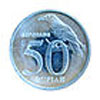|

_banknotes.jpg)
The rupiah (Rp) is the official currency of Indonesia. Issued and controlled by the Bank of Indonesia, the ISO 4217 currency code for the Indonesian rupiah is IDR. The name derives from the Indian monetary unit rupee which is called as rupiya in Indian languages. Informally, Indonesians also use the word "perak" ('silver' in Indonesian) in referring to rupiah. The rupiah is subdivided into 100 sen, although inflation has rendered all coins and banknotes denominated in sen obsolete.
The Riau islands and the Indonesian half of New Guinea (Irian Barat) had their own variants of the rupiah, but these were subsumed into the national rupiah in 1964 and 1971 respectively (see Riau rupiah and West New Guinea rupiah).
Current legal tender
The current rupiah consists of coins from 25 rupiah up to 1,000 rupiah (1 rupiah are officially legal tender but are effectively worthless and are not circulated), and from banknotes of 1,000 rupiah up to 100,000 rupiah. With US$1 generally worth about 10,000 rupiah, the largest Indonesian banknote is therefore worth around US$10.
Coins
There are presently two series of coins in circulation: aluminium bronze and bi-metallic coins from 1991–1998 and light-weight aluminium coins from 1999 onwards. Due to the low value and general shortage of small denomination coins (below 100 rupiah), it is common to have amounts rounded up (or down) or to receive sweets in lieu of the last few rupiah of change in supermarkets and stores.
Banknotes
Currently circulating Indonesian banknotes date from 2000 (1000 rupiah), 2001 (5000 rupiah), 2004 (20000 and 50000) rupiah, 2005 (10000 and 100000 rupiah), 2009 (the new 2000 rupiah), and 2010 (revised version of the 10000) rupiah. The 1998–1999 notes have no longer been legal tender since 31 January 2008 (but will be exchangeable until 31 January 2018 at Bank Indonesia). Earlier notes are also no longer legal tender, due to the lack of security features and association with the Suharto regime, and can be exchanged in Bank Indonesia offices only until August 20 2010.
As the smallest current note is worth approximately US$0.10, even small transactions such as bus fares are typically conducted with notes, and the 1,000 rupiah note is far more common than the 1,000 rupiah coin. The government initially announced that this would change, with a 2000 rupiah note to replace the 1000 rupiah, with that denomination replaced by a coin. After a long delay, this proposal was revised so that the 2000 rupiah banknotes was launched by BI (Bank Indonesia) on 9 July 2009, with the banknotes circulating as legal tender from 10 July 2009, but without withdrawing the 1000 rupiah note.
Due to the low value of the (older series) notes below 1000 rupiah, although they are no longer being circulated, some remain in use in increasingly poor condition, as low denomination 'uang pasar' (literally market money), outside the banking system for use in informal transactions.
Security features
* The materials of the banknotes basically are long fibres from any kind of wood, or a mix of different types of wood. However, the preferable material is the Abaca fibre, which is naturally plentiful in Indonesia and is believed to increase the durability of the banknotes. The banknotes are made with the process of heating, to create a unique type of pulp.
* The minimum security features for naked eyes are watermarks, electrotypes and security threads with color fibres. In addition to this, extra features may be included, such as holograms, Irisafe, iridescent stripes, clear windows, metameric windows and gold patches.
o Watermark and Electrotype are made by controlling the gap of density of the fibres which create certain images for the banknotes. This is done to raise the quality of the notes from the aesthetic view.
o Security threads are put in the middle of the note's materials so horizontal and vertical lines are shown from top to bottom. The threads also can be made with many variations such as the materials, size, color and design.
* The 2010 10,000 rupiah introduced several new security features: use of EURion constellation rings, rainbow printing designed to change colour when viewn from different angles, intaglio printing (for the blind).
The text on this page has been made available under the Creative Commons Attribution-ShareAlike License and Creative Commons Licenses
| 